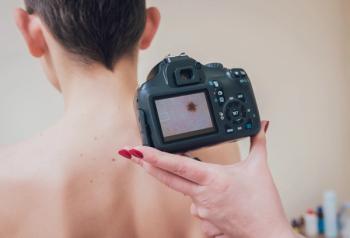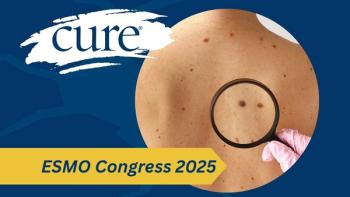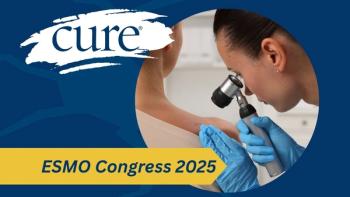
- Summer 2006
- Volume 5
- Issue 2
Nonmelanoma Skin Cancer: Saving Your Skin
Treating and preventing the nation's most common cancer.
Geary Corves knows a thing or two about the sun and skin cancer. Now 80 years old, he's had more than 30 small skin cancer spots removed over the past 40 years. "I noticed something on my forehead," he recalls about the first time he saw a dermatologist. "It was some kind of sore." Corves' doctor used radiation to remove that first lesion, which turned out to be basal cell carcinoma. Since then, Corves has seen great changes in the medical community's understanding and treatment of skin cancer.
More than one million people will get skin cancer this year, estimates the American Cancer Society. The majority of skin cancers come in two forms: melanoma, which arises from cells in the skin called melanocytes and accounts for approximately 4 percent of all skin cancers, or nonmelanoma skin cancer, which arises from cells in the skin called keratinocytes and accounts for approximately 95 percent of all skin cancers. Other rare forms of cancer, like cutaneous lymphoma or Kaposi’s sarcoma, make up the remaining skin cancers.
Nonmelanoma skin cancer is divided into two kinds, depending upon which type of keratinocyte the malignant cells start in. Basal cell carcinomas comprise approximately 75 percent of all nonmelanoma skin cancers and originate from keratinocytes in the basal (bottom) layer of the epidermis, the outer covering of the skin. Basal cell carcinomas usually occur on the face, head, neck or other skin areas that tend to be exposed to the sun. Squamous cell carcinomas stem from keratinocytes in the uppermost layer of the skin and account for the other quarter of nonmelanoma skin cancers. A precancerous lesion called actinic keratosis often precedes squamous cell skin cancer. People with numerous actinic keratosis lesions have about a 10 percent risk of squamous cell cancer in their lifetime. Squamous cell cancer also sometimes presents as a superficial malignancy called Bowen’s disease. Unlike basal cell cancer, which rarely metastasizes, squamous cell cancer runs a 5 to 10 percent risk of spreading throughout the body.
Over the next few decades, experts expect an increasing number of nonmelanoma skin cancers will be found, says Vernon Sondak, MD, chief of the cutaneous oncology program at H. Lee Moffitt Cancer Center and Research Institute in Tampa. Much of the increase will be related to the greater amounts of current sun exposure. You know, 150 years ago people went out in the sunshine totally clothed from head to toe with big floppy hats, no matter how hot it was, says Dr. Sondak. During the second half of the past century, however, sun tanning became very popular and wearing tank tops, shorts and bikinis became acceptable. As people increased their sun exposure throughout the 20th century, more nonmelanoma skin cancers developed. Furthermore, while nonmelanoma skin cancers most often affect people over 50, more men and women are being diagnosed under age 40.
When I was a kid I spent a great deal of time in the sun, says Corves. He says that every summer he would burn, then get very dark. At 19 years old he entered the military and spent a couple of years in India out in the sun without a shirt. Being fair-skinned and light-haired, Corves skin was particularly susceptible to the damaging rays of the sun that trigger the skin cancer process. I pushed my skin to the limits, he says.
Dermatologists now know that sunlight can directly damage the skin. Sunlight carries three types of ultraviolet (UV) radiation—waves of electromagnetic energy that move through the air. UVA radiation has a wavelength of 280 to 320 nanometers (one nanometer equals one-billionth of a meter), UVB radiation has a wavelength of 320 to 400 nanometers and UVC has a wavelength of 200 to 290 nanometers. Most sunlight that reaches Earth’s surface consists of about 90 percent UVA and 10 percent UVB (the ozone layer completely absorbs UVC). Artificial light from tanning beds and salons also release UVA and UVB.
UVA and UVB both have a relationship to skin cancer, says Desiree Ratner, MD, director of dermatologic surgery at the Melanoma Center at Columbia University Medical Center in New York. She explains in an article in The New England Journal of Medicine that the electric and magnetic components of UV radiation can penetrate the skin and damage protein or DNA components of skin cells. In fact, scientists have discovered that UV radiation can induce specific changes, or mutations, in certain tumor-suppressor genes, the most common of which is called p53. If a skin cell has one of these damaged, or mutated, p53 genes, it will probably just die. But, if the skin cell has two of these mutated p53 genes, either because of chronic sun exposure or because the person was born with one damaged gene already, then the skin cell will undergo abnormal growth that may lead to cancer. UV radiation can also decrease the skin cells immune system and, thereby, lessen the skin's ability to detect or kill off abnormal and mutated cells.
Although the complete effects of UV radiation on skin cells remain unknown, chronic sun exposure appears to be the biggest risk factor for nonmelanoma skin cancer. The more sun exposure you have, the more likely you are to get nonmelanoma skin cancer, says Dr. Sondak. This may be in contrast to melanoma where occasional sunburns, perhaps even one, appear to increase the chance of malignant melanoma. Nonmelanoma skin cancers appear most commonly on sun-exposed areas, but may occasionally develop in places on the body that get little sun.
Like Corves, Kathy Bilodeau, a 56-year-old from Connecticut, spent a lot of time in the sun as a kid. I grew up in California. I didn't think anything of it, she says. Unlike Corves, however, Bilodeau has olive-colored skin and dark hair. About 10 years ago, Bilodeau developed a wart-like growth on her forehead that would break off and bleed but kept returning. Nonmelanoma skin cancers may present in many different forms, from small sores to large bumps, which dermatologists learn to recognize.
After several months, Bilodeau went to see a dermatologist, who removed the lesion and diagnosed it as squamous cell carcinoma. Since then she has visited the doctor every six months for total body skin checks. Four other small cancerous spots have been detected and removed.
Other risk factors, besides sun exposure, can also make someone more susceptible to developing nonmelanoma skin cancer. As Corves and Bilodeau experienced, getting one skin cancer greatly increases the chance of developing another skin cancer, which may be of any type, including melanoma.
Like Corves, fair skin or light hair heightens susceptibility of developing nonmelanoma skin cancer. Living in a sunnier climate, higher altitude or closer to the equator can increase susceptibility, as does smoking, exposure to arsenic or ionizing radiation and sunbed use. Also, people who have had an organ transplant or who must take immunosuppressive drugs like steroids for a long time develop nonmelanoma skin cancer more easily than other people. Recently, scientists discovered that a common virus, called human papillomavirus, may also be involved in triggering some nonmelanoma skin cancers.
Genetics plays a big role in risk for nonmelanoma skin cancer. Scientists have recently traced a genetic defect involved in initiating nonmelanoma skin cancer to chromosome 9. The genetic defect involves a protein called patched homologue 1 (PTCH1) that fights the development of tumor cells. PTCH1 is part of a chain reaction in skin cells called the sonic hedgehog pathway, which has been detected in some basal cell cancers, says Chrysalyne Schmults, MD, assistant professor of dermatology at the University of Pennsylvania. When this pathway is altered you end up with abnormalities in how rapidly cells proliferate, says Dr. Schmults. Experiments in mice suggest that the PTCH1 defect may make the hedgehog pathway more susceptible to the damaging effects of radiation. Continued research into the genetics of nonmelanoma skin cancer should enhance the development of preventive methods and treatment strategies for these conditions.
Nonmelanoma skin cancers are highly curable with fewer than 3,000 deaths each year, but they still require treatment, says Dr. Sondak. Nonmelanoma skin cancers can look disfiguring, they can be a site for infection and, if neglected, they will grow larger and may spread to other parts of the body. Removing nonmelanoma skin cancer completely and getting all its roots out will usually cure it, says Dr. Sondak. Fortunately, he adds, many effective treatments exist.
One of the most common methods to treat small and superficial nonmelanoma skin cancers, called electrodesiccation and curettage, involves drying or burning the spot with electricity and then scraping it off. Other small lesions or precancerous spots may be destroyed by cryotherapy, which freezes off the malignant skin. Because these techniques destroy the unwanted skin, the doctor has no tissue sample to examine under a microscope after the procedure, making it hard to know if all the malignant cells were removed. For small, superficial lesions, however, microscopic analysis may not be that important.
A dermatologist or surgeon can surgically cut, or excise, larger nonmelanoma skin cancer lesions right out of the skin. Excised tissue can be examined under a microscope to make sure the whole tumor has been removed, but a lot of surrounding normal skin is frequently cut off with the excised lesion, leaving large scars that may require plastic surgery or treatment with a laser for repair.
A more sophisticated surgical method to remove nonmelanoma skin cancers, called Mohs surgery, was developed in the 1950s. During Mohs surgery, named for its inventor Frederick Mohs, MD, a specially trained dermatologist or surgeon removes thin slices of the cancerous area, one by one, and examines each slice under a microscope until no tumor cells remain. This technique can be time-consuming, but Mohs surgery is an ideal approach when the nonmelanoma cancer is someplace where you would like to get the tumor out completely and take a minimum amount of normal tissue around it, says Dr. Sondak. Skin cancer experts frequently recommend Mohs surgery for lesions on the tip of the nose, on the edge of the ear or in the middle of the cheek.
Donna Groon, a 53-year-old teacher who lives on the New Jersey shore, had a nonmelanoma skin cancer removed by Mohs surgery three years ago. I had a scaly mark on my nose that would peel and bleed but just wouldn't go away, she says. After a biopsy revealed basal cell carcinoma she underwent Mohs surgery to remove it. I was very pleased with the results and I have had no recurrence, says Groon, who underwent laser surgery after Mohs to improve the look of her skin.
Some people have many small but superficial nonmelanoma skin cancers or precancerous spots. Topical ointments applied directly on the skin can get rid of some of these lesions. A cream of 5-fluorouracil (5-FU), a chemotherapy drug, can burn off precancerous lesions or superficial skin cancers. Corves tried the 5-FU cream four or five times, but it can be messy and burn other areas of the skin if not carefully applied.
Dermatologists are excited about a new topical agent called Aldara (imiquimod). Aldara causes a powerful immune response on any skin it touches and is currently approved for treatment of superficial basal cell carcinoma and actinic keratosis. Basically, says Dr. Sondak, the patient's own immune system rushes in to attack this cream and destroys all these other cancer cells. While Aldara shows promise for some small nonmelanoma skin cancers, it is not as effective as surgical methods for removing larger skin tumors.
Yet, more options exist for treating nonmelanoma skin cancers. For people who can't undergo surgery, radiation may be offered. Radiation for nonmelanoma skin cancer works similarly to radiation for other cancers and usually requires daily treatments for several weeks. Photodynamic therapy, another nonsurgical method to treat nonmelanoma skin cancer, involves applying Levulan Kerastick (5-aminolevulinic acid, or 5-ALA) to the skin under a specialized light that activates the acid to destroy cancer cells. Like other topical treatments, photodynamic therapy appears most effective for small nonmelanoma cancers or precancerous areas, says Dr. Schmults.
Novel approaches to treating nonmelanoma skin cancers appear on the horizon. Cyclopamine, a drug that blocks the changes to the hedgehog pathway that induce nonmelanoma skin cancers, is in phase I testing. Another ointment called Dimericine, made up of a DNA repair enzyme called T4 endonuclease V, or T4N5, seems to help prevent early skin cancers in susceptible people. An initial study of Dimericine in 30 people found it significantly decreased the development of precancerous spots. A phase II trial testing Dimericine as a preventive agent for nonmelanoma skin cancer is currently under way.
Although many options for treating nonmelanoma skin cancer exist and new approaches are expected in the future, most experts feel prevention should be the message when talking about skin cancer. If you protect yourself, you can lessen the risk of developing skin cancers over time, says Dr. Ratner. But dermatologists also recognize that people need not be afraid of the sun. Even nonmelanoma skin cancer survivors want to enjoy themselves in the sun.
Last year Groon spent seven days in Arizona on vacation. She wore hats and sunblock with SPF 30 and returned home without a tan. But she still went outside and rode horseback in the desert. I did it all, she says, without taking a risk. It can be done.
Articles in this issue
almost 17 years ago
Glossaryalmost 17 years ago
Breast Cancer & MDSover 19 years ago
Confronting Deathover 19 years ago
Surf & Turfover 19 years ago
A Beautiful Day: The Story of a Son's Lossover 19 years ago
People & Placesover 19 years ago
The Blame Gameover 19 years ago
Running on Emptyover 19 years ago
Fighting Cancer Togetherover 19 years ago
Cancer as a Legacy




